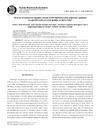Identificador persistente para citar o vincular este elemento:
https://accedacris.ulpgc.es/jspui/handle/10553/45424
| Título: | Effects of extensive system versus semi-intensive and intensive systems on growth and carcass quality of dairy kids | Autores/as: | Zurita Herrera, Pedro Delgado Bermejo, Juan Vicente Argüello Henríquez, Anastasio Camacho Vallejo, María Esperanza Germano Costa, Roberto |
Clasificación UNESCO: | 3104 Producción Animal | Palabras clave: | Meat Quality Live Weight Goat Slaughter Attributes, et al. |
Fecha de publicación: | 2011 | Editor/a: | 1516-3598 | Publicación seriada: | Revista Brasileira de Zootecnia | Resumen: | The aim of this research was to study the effects of three different management systems on growth and carcass quality of 61 Murciano-Granadina breed kids and their interaction with sex. In the extensive system, 21 kids were allocated to suckle from their dams on free-range pasture with no additional feedstuff. In the semi-intensive system, 20 kids were suckled from their dams and had access to alfalfa hay and cereal straw (no free-range pasture). In the intensive system, 20 kids were separated from the dams at birth and then fed with milk replacer and alfalfa hay. Animals were slaughtered at 7.00 ± 1.00 kg of average BW. The semi-intensive system and extensive system kids grew faster than intensive system animals (127, 113 and 96 g/d, respectively). Differences in energy intake may explain these differences. Intensive system kids displayed the lowest real dressing percentages, calculated as 100 × (hot carcass weight/empty body weight), due to high development of empty gastrointestinal tract. The long leg and carcass were larger in extensive system kids than in kids from other management systems, presumably due to high physical activity on the free-range pastures. The carcasses and cuts from semi-intensive system and extensive system kids displayed more fat than those of intensive system kids. Males grew faster than females (122 and 103 g/d, respectively). Carcasses in male kids showed a higher content of bones but a lower content of fat than carcasses in female kids. The extensive system is feasible for producing kid meat from a dairy breed. | URI: | https://accedacris.ulpgc.es/handle/10553/45424 | ISSN: | 1516-3598 | DOI: | 10.1590/S1516-35982011001100045 | Fuente: | Revista Brasileira de Zootecnia [ISSN 1516-3598], v. 40, p. 2613-2620 |
| Colección: | Artículos |
Citas SCOPUSTM
15
actualizado el 08-jun-2025
Citas de WEB OF SCIENCETM
Citations
10
actualizado el 08-jun-2025
Visitas
145
actualizado el 17-may-2025
Descargas
96
actualizado el 17-may-2025
Google ScholarTM
Verifica
Altmetric
Comparte
Exporta metadatos
Los elementos en ULPGC accedaCRIS están protegidos por derechos de autor con todos los derechos reservados, a menos que se indique lo contrario.
